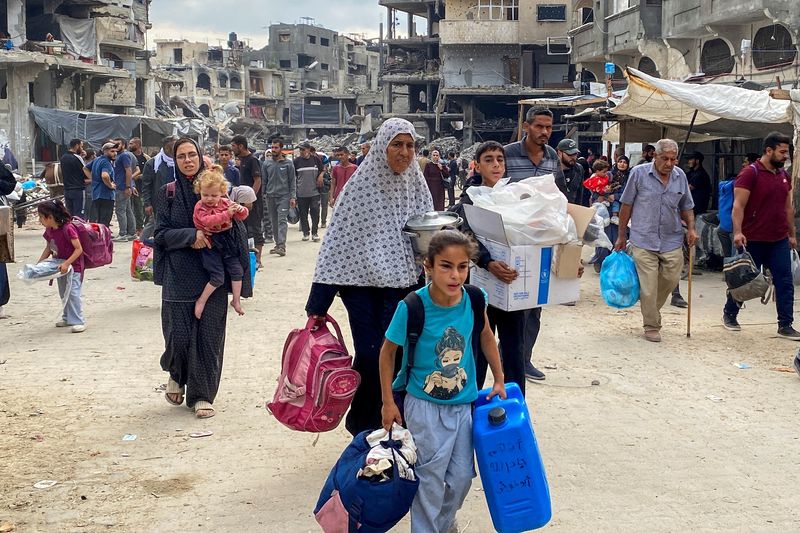By Nidal al-Mughrabi
CAIRO (Reuters) -Israeli forces tightened their squeeze around Jabalia in northern Gaza on Monday, killing at least 10 people queuing for food, according to Palestinians medics, and instructing people to evacuate as they pushed in against Hamas fighters.
Jabalia has been the focus of an Israeli offensive for around 10 days and the military has now encircled the camp and sent tanks into nearby Beit Lahiya and Beit Hanoun towns, with the declared aim of stamping out Hamas fighters who are trying to regroup there.
Jabalia is home to one of eight historic refugee camps in the Gaza Strip. As the operation has continued, people there have been caught between Israeli demands to move south and Hamas calls not to leave because it was too risky to do so.
"We have been hit from the air and the ground, non-stop for a week, they want us to leave, they want to punish us for refusing to leave our homes," said Marwa, 26, who left with her family to a school in Gaza City.
People were afraid they would never be able to return if they head south, she said.
The United Nations human rights office said the Israeli military appeared to be "cutting off North Gaza completely from the rest of the Gaza Strip".
"The separation of North Gaza raises further concerns that Israel does not intend to allow civilians to return to their homes, and the repeated calls for all Palestinians to leave northern Gaza raise grave concerns of large-scale forced transfer of the civilian population," it said in a statement.
Israeli officials said evacuation orders were aimed at separating Hamas fighters from civilians and denied that there was any systematic plan to clear civilians out of Jabalia or other northern areas.
On Monday, the military said it had killed the head of Hamas' aerial unit, Samer Abu Daqqa, who it said was among those responsible for the use of paragliders by Hamas gunmen during the Oct. 7 attack on Israel.
But the operation has underlined how impossible life has become for Gaza civilians as fighting has shifted between different areas of the enclave.
Ten people were killed and 40 wounded by tank shelling on Monday in Jabalia, including women and children, Palestinian medics said, while another eight were killed in a separate incident in Gaza City's Sheikh Radwan district.
The Israeli military said the incident was under review. "The IDF directs its strikes and operations only against terror targets and operatives and does not target civilian objects and civilians," it said.
The United Nations has described dire conditions affecting the civilian population remaining in Jabalia, with more than 50,000 people displaced and water wells, bakeries, medical points and shelters shut down.
UN Secretary-General Antonio Guterres on Monday condemned the level of civilian casualties in northern Gaza.
The White House National Security Council spokesperson said Israel has a responsibility to do more to ensure Palestinian civilians were not harmed by its attacks against Hamas.
He was commenting on an Israel missile attack on tents inside Al-Aqsa Hospital in the city of Deir Al-Balah in the central Gaza Strip, which killed four people and wounded dozens of others. Israel said the strike targeted Hamas militants.
The White House comments appeared to have come following the posting of videos on social media platforms of what appeared to be Palestinians burning alive in the tents set ablaze by the missiles.
"The images and video of what appear to be displaced civilians burning alive following an Israeli air strike are deeply disturbing and we have made our concerns clear to the Israeli government," the spokesperson said.
"Israel has a responsibility to do more to avoid civilian casualties - and what happened here is horrifying, even if Hamas was operating near the hospital in an attempt to use civilians as human shields," the spokesperson added.
The northern part of Gaza, home to well over half the territory's 2.3 million people, was heavily bombed in the first phase of Israel's assault on the territory and hundreds of thousands of residents quit their homes following Israeli evacuation orders.
Around 400,000 people remained, according to United Nations estimates.
Hamas said Israel aimed to displace the people of northern Gaza by force. "The international community should act against this war crime," said senior Hamas official Sami Abu Zuhri.
FORMER GENERALS' PROPOSAL
Fears that Israel intends to empty northern areas have been fuelled by a proposal floated by former Israeli generals, which calls for north Gaza to be cleared of civilians and remaining militants to be put under siege until they surrender.
The military has denied such designs.
"We have not received a plan like that," military spokesperson Nadav Shoshani told reporters. "We are making sure we're getting civilians out of harm's way while we operate against those terror cells in Jabalia," he said.
The proposal's main author, Giora Eiland, said his plan was meant to pressure Hamas to release hostages by ending its control of territory and aid, rather than sending Israeli forces in to battle its fighters.
"What they're doing in Jabalia now is more of the same," Eiland told Army Radio on Sunday. "My plan is not being implemented."

Israel's plans for the future of Gaza are unclear, beyond its stated aim of dismantling Hamas as a military and governing force and recovering its hostages.
Israel launched the offensive against Hamas after its Oct. 7 attack on Israel, in which 1,200 people were killed and around 250 taken hostage to Gaza, by Israeli tallies. More than 42,000 Palestinians have been killed in the offensive so far, according to Gaza's health authorities.
